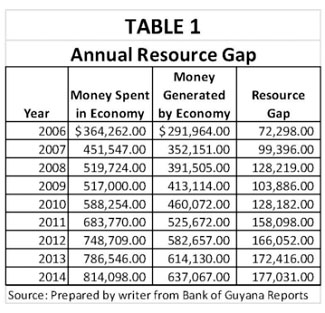Resource gap
The Bank of Guyana has been reporting for some time now on what it refers to as the resource gap. This variable is the difference between the money generated in the economy within a year from the economic activities that have been reported and the money spent to produce and consume goods and services. It is the money earned by labour and capital that is then used to buy the goods and services that were produced in Guyana. Table 1 below shows that the gap between the two variables has been steadily growing and, ignoring the sign, has always been negative. This means that Guyanese has had to find extra money continuously to gain access to the things that they have been consuming. The overall gap ‒ the amount which cannot be accounted for by any of the other official financial flows ‒ has been growing by 14 per cent each year. The question then is from where have the extra resources been coming? This article seeks to examine this issue in light of the constant concerns being expressed about money laundering and suggests that the problem persists because of a lack of cooperation among critical state institutions.
Money generated
 The money generated by the economy and the spending by Guyanese have been keeping pace with each other at 10 per cent per annum since 2007, even though that spending has shown a marked decline every year since 2011. Spending increased 16 per cent in 2011 over the 2010 period. Ever since then, it has been increasing at a decreasing rate, falling to nine per cent in 2012, five per cent in 2013 and four per cent in 2014. The income generated by the economy
The money generated by the economy and the spending by Guyanese have been keeping pace with each other at 10 per cent per annum since 2007, even though that spending has shown a marked decline every year since 2011. Spending increased 16 per cent in 2011 over the 2010 period. Ever since then, it has been increasing at a decreasing rate, falling to nine per cent in 2012, five per cent in 2013 and four per cent in 2014. The income generated by the economy

